Louisiana crawfish tails smothered in a rich gravy, that's Crawfish Etouffée. It starts with the Trinity and seasonings cooked into a roux, then slowly drowned in a flavorful stock. The result is a hearty, velvety gravy filled to the brim with crawfish tails. Sounds good? It's actually one of the simplest dishes you will ever make and believe me, everyone will love it. I'm excited to show you my simple, delicious recipe for classic Cajun Crawfish Etouffée.
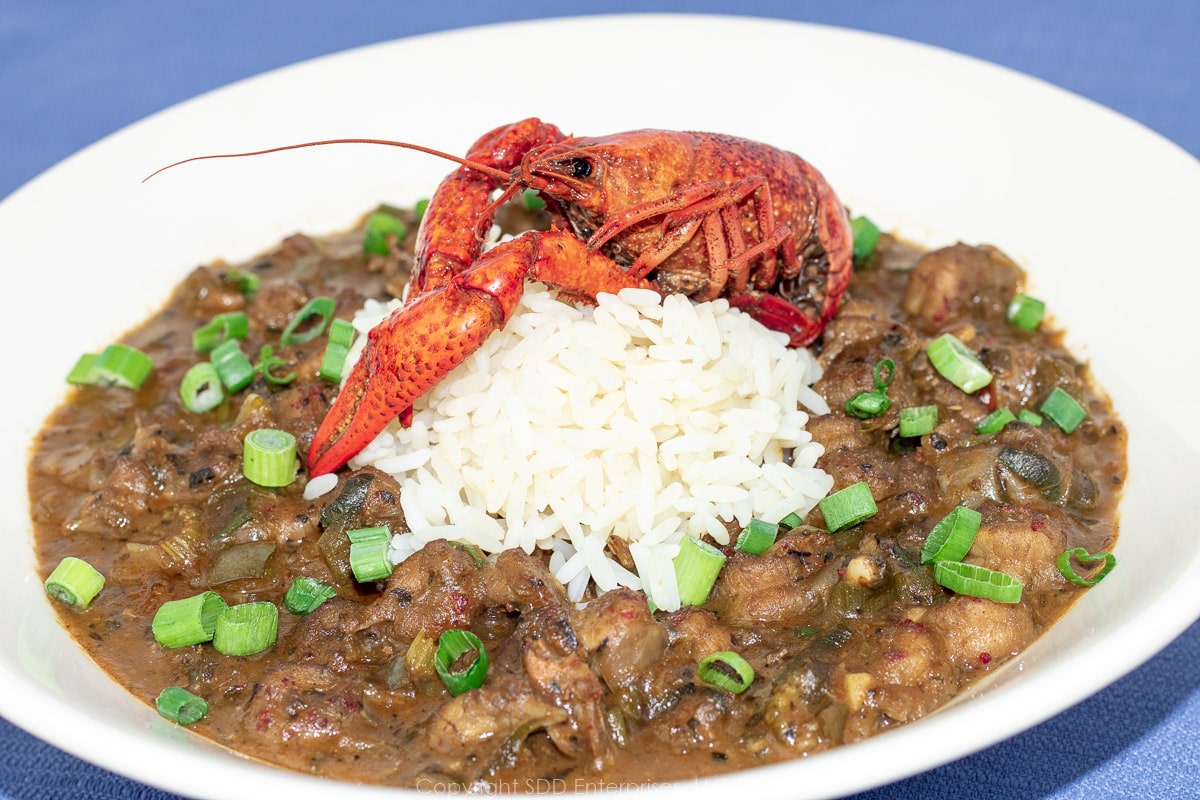
If you want to just skip to the recipe, click the "Jump To Recipe" button above or the Recipe link below and you’ll go right there without having to scroll through my article.
[Publisher's Note: This article was originally published in April 2018 and revised in April 2020. I am republishing this now with technical updates, improved images, and more details on the process of making Crawfish Etouffée. I hope you find this helpful and look forward to your questions and comments.]
This post is not sponsored, but you will find affiliate links on this page. As an Amazon Associate, I earn from qualifying purchases. The price you pay as a consumer does not change, but I may make a small commission based on your purchase.
Jump to:
What is Crawfish Etouffée?
The term etouffée refers to the cooking method: something smothered, braised, or stewed in a liquid. It's usually shellfish, game, or meat, but can be just about anything else. There are both Cajun and Creole interpretations of this classic South Louisiana dish with slight variations related to regional culinary variations. Sweet Daddy D's Crawfish Etouffée is a Cajun version that uses a roux-based gravy to smother crawfish tails. It's simple in its preparation and deeply flavorful.
It's no wonder that Crawfish Etouffée is one of the most popular ways to enjoy crawfish. It should be no surprise that like any cuisine with such deep historic roots, there is no one recipe that's accepted by all Cajun or Creole cooks for many iconic dishes. Crawfish Etouffée is certainly no exception. Every chef and cook has their own recipe to make it and will argue endlessly that theirs is the best way. Treat yourself, try different versions. The problem is, you'll love them all.
Here is What You Need
Here are some of the key ingredients for this recipe:
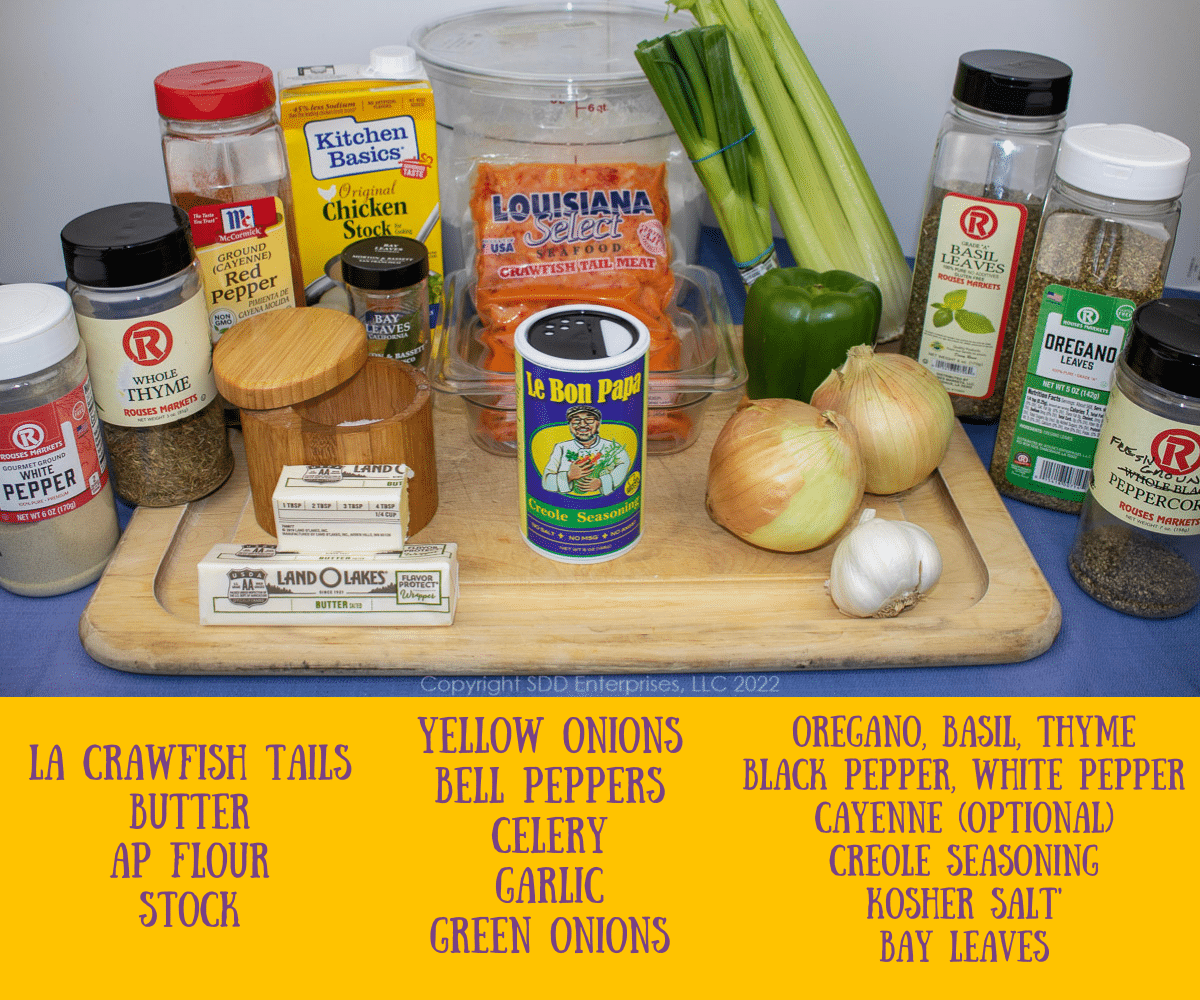
Note on the Crawfish Tails: Freshly parboiled crawfish or leftover crawfish tail meat from a Crawfish Boil are both great for this recipe. Frozen crawfish tails are also perfect for this recipe. I recommend only Louisiana Crawfish Tails. Many seafood markets and groceries sell imported crawfish which I believe are inferior in taste to Louisiana mudbugs. Check out the Hints and Tips section below for a little more on sourcing your crawfish.
Note on the stock: This recipe is best with Crawfish Stock, which is simple to make if you have crawfish shells and heads. If you don't have crawfish stock, chicken stock is an excellent substitute. Honestly, it's what I use most of the time because, with so many uses, it's hard to keep crawfish stock in the freezer. Vegetable or seafood stocks are also acceptable, but will not provide quite the flavor of the others. Plain water is an option if you have no others.

Equipment
Here is some of the equipment I used in making this recipe:
This post is not sponsored, but you will find affiliate links on this page. As an Amazon Associate, I earn from qualifying purchases. The price you pay as a consumer does not change, but I may make a small commission based on your purchase.
Note: This is a two-pot process, so you'll need a Dutch oven to make the gravy and a stockpot in which to simmer the stock and mix it all together.
These will come in handy when making this recipe:
Here's What You Do
First... you have a beer. This is a great and fun recipe to cook with and for friends and family and a couple of beers goes well with that. Your mise en place actually starts with a beer to help establish the right attitude. While you sip that, read the recipe completely so you'll know what you need and what you'll do with each. Gather the ingredients and equipment you'll need, then start the prep work.
Mise en Place
Prepare the crawfish tails.
If you're using leftover tail meat from a boil, make sure the veins are cleaned off, and hopefully, you've gotten some reserved fat. Thaw frozen tails and place them in a bowl. (Remember to rinse them thoroughly ONLY if they are imported tails or have been frozen for over 5 months-see the Hints and Tips section below for more on that). Mix in a little Creole Seasoning into the tails and set them aside.
Dice the Trinity (yellow onions, bell peppers, and celery) and place them in one prep bowl together. Slice the green onions and give the garlic a rough chop, then place each in a separate bowl and set aside.
In another small bowl combine the Herb and Spice blend and set it aside. Set the butter out to soften and measure the flour and stock.
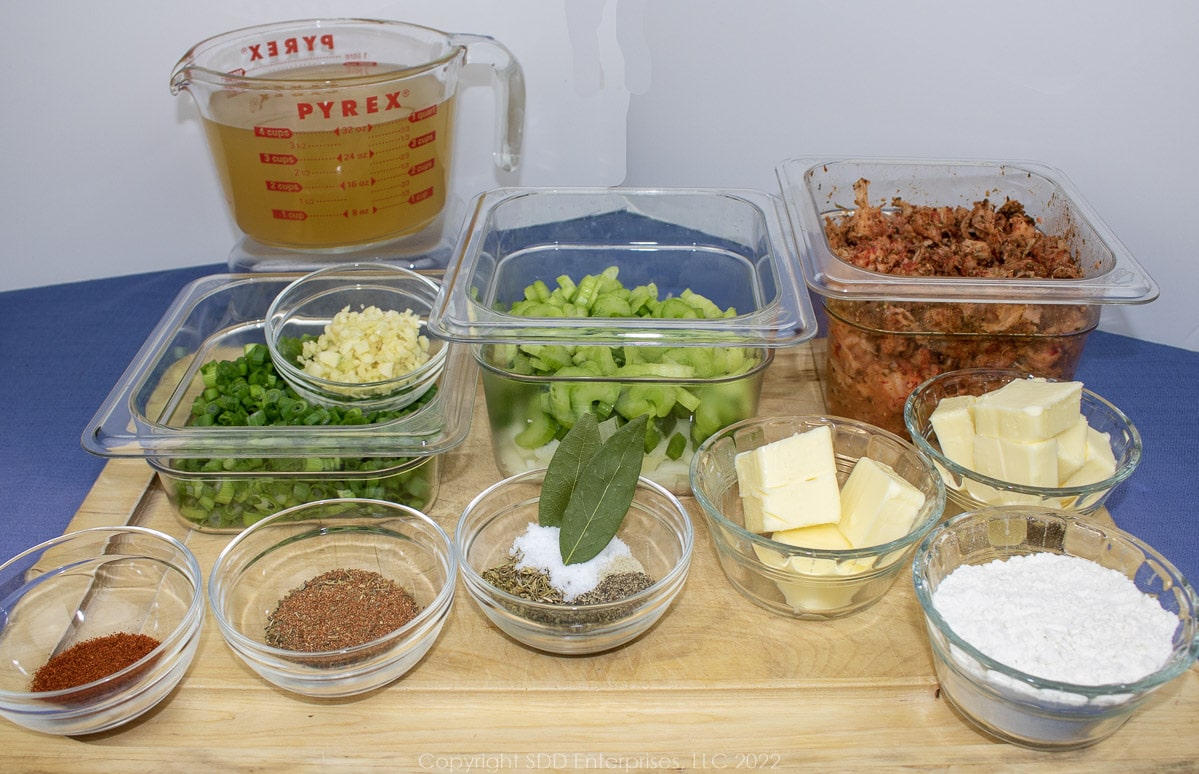
Set up two pots
This is a two-pot recipe, one to make the roux mixture and to finish the etouffée and another to make the gravy. Set up a cast iron dutch oven with a lid and a stockpot with a lid. Start by placing 3 cups of the stock in the stockpot and let it sit-make sure to reserve that extra stock in case you need to thin things out later. Now you have everything together and prepped, so you can concentrate on the process of building this delicious classic. How’s your beer?
Start with the roux
What happens in this step? We are wanting a smooth, thickish gravy to smother the flavorful crawfish tails. That starts with a great roux. Take your time building this important first layer of flavor.
Set the Dutch oven over medium-high heat and add the butter. When the butter starts to bubble, add the flour and whisk continuously to make a medium-colored roux, sort of like peanut butter.

Lagniappe Tip: Make the roux just lighter than you think it needs to be because it will continue to cook and darken after you add the veggies. The only way to ruin the roux is to burn it. If you are not experienced in making a roux, use low or medium heat. It will take longer, but you will be able to see how it's browning and control it better. If it's getting too hot, simply remove it from the heat for a few minutes. When you are more comfortable making a roux, use whatever heat level you like. If it burns, throw it out, have another beer and start over.
Add in the trinity, garlic, green onions, and spices
What happens in this step? The second layer of flavor comes from extracting great flavor from the Trinity, garlic, and spices in this step.
Once you have the roux looking like you want, slide the Dutch oven off the heat and add the Trinity. That's the yellow onions, celery, and bell peppers.
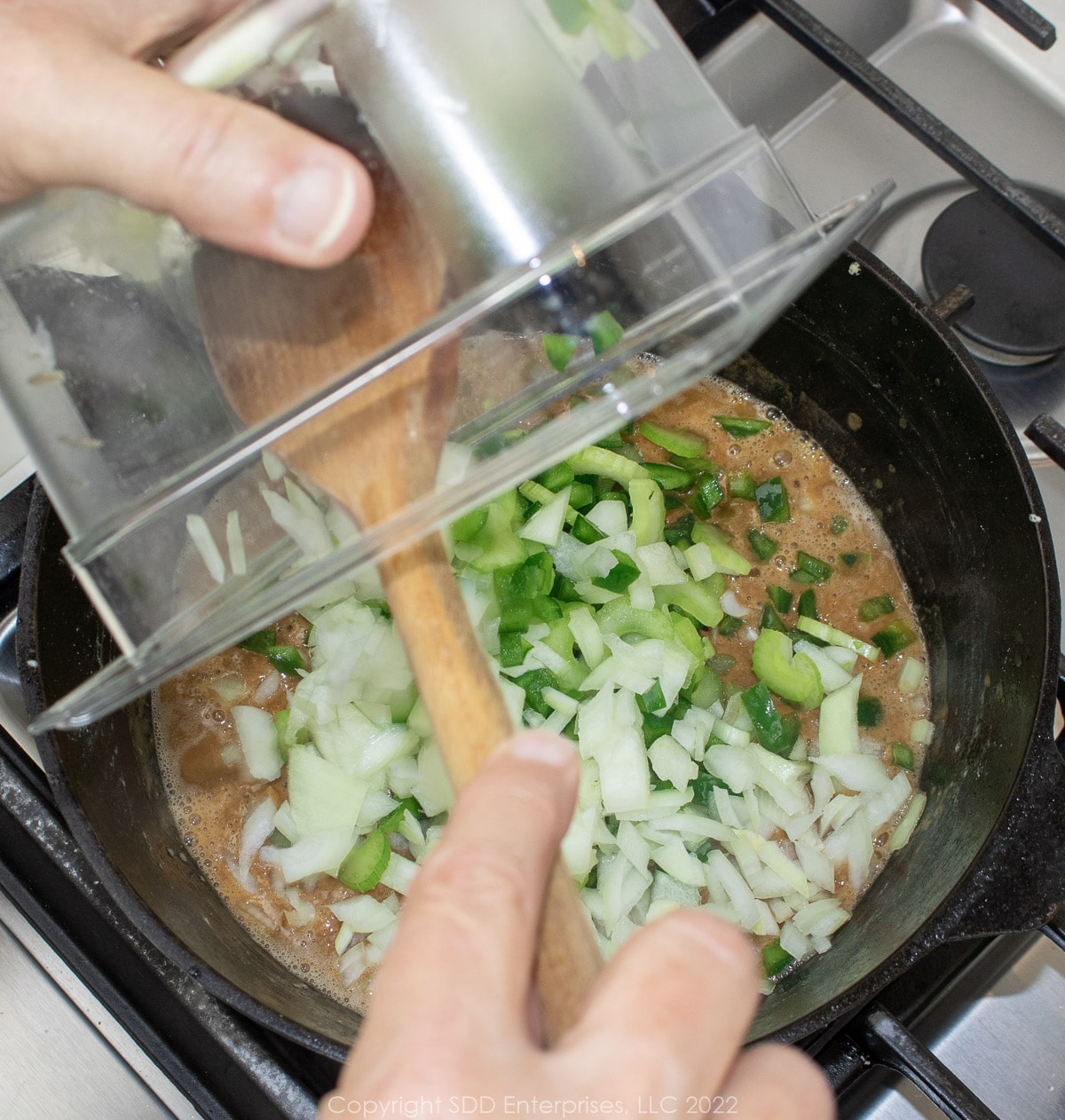
Lagniappe Tip: To make sure the heat doesn't get away from you, remove the Dutch oven from the heat while you steadily stir all the ingredients together. This will help control the heat and not overbrown your gravy.
Once the Dutch oven has cooled considerably, return the Dutch oven to medium or medium-high heat. Continue to sauté, stirring frequently until the onions begin to caramelize, which will take 12 to 15 minutes. Scrape any bits of goodness that stick to the bottom of the pot and mix that into the Trinity. Those little bits are called fond and are packed with flavor. It's ready for the next step when all the vegetables are evenly coated with the roux.
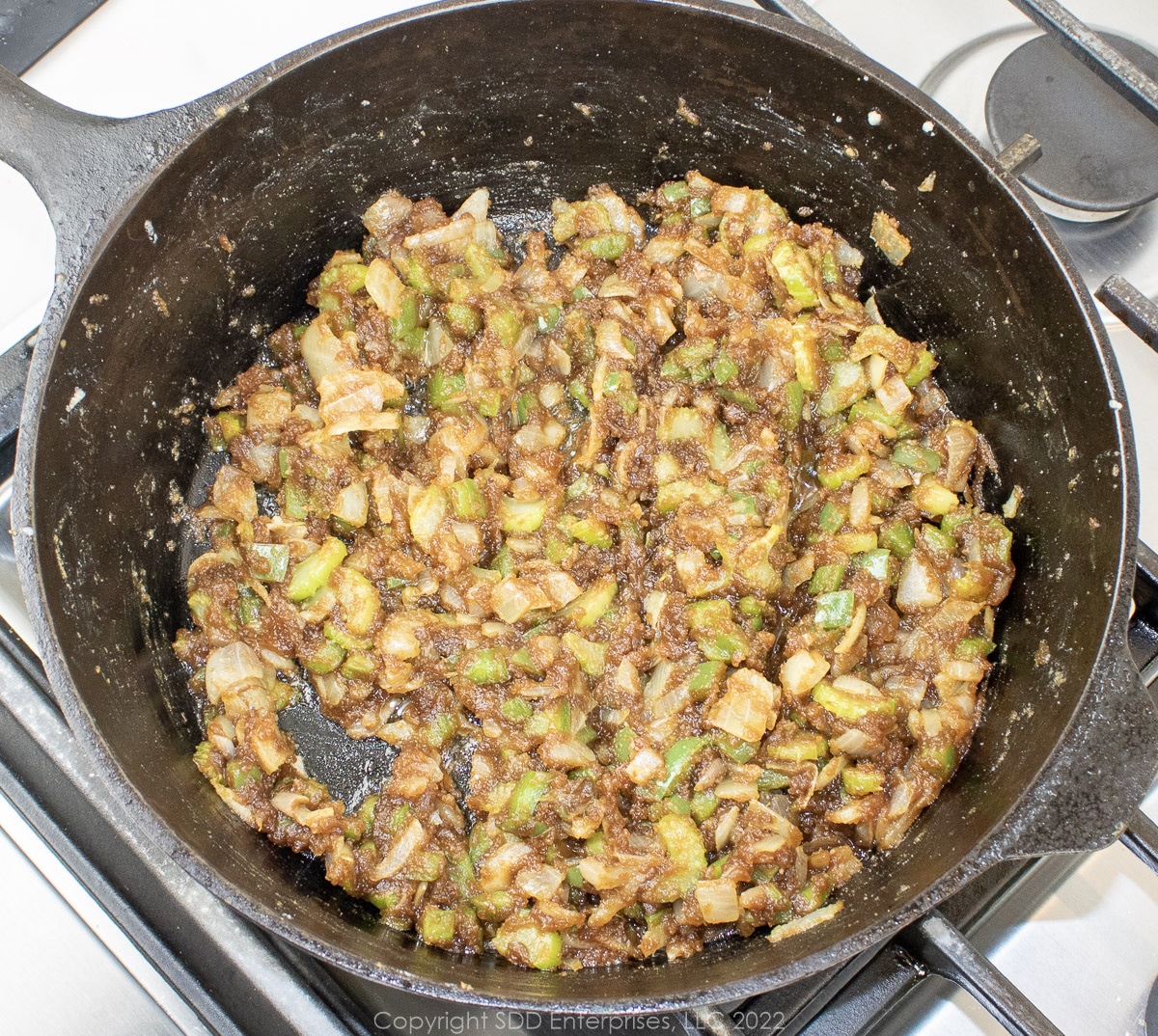
Once the Trinity is coated in the roux, add the garlic and about half the green onions (reserve some green onions for later). Sauté everything until aromatic, about 1 or 2 minutes.
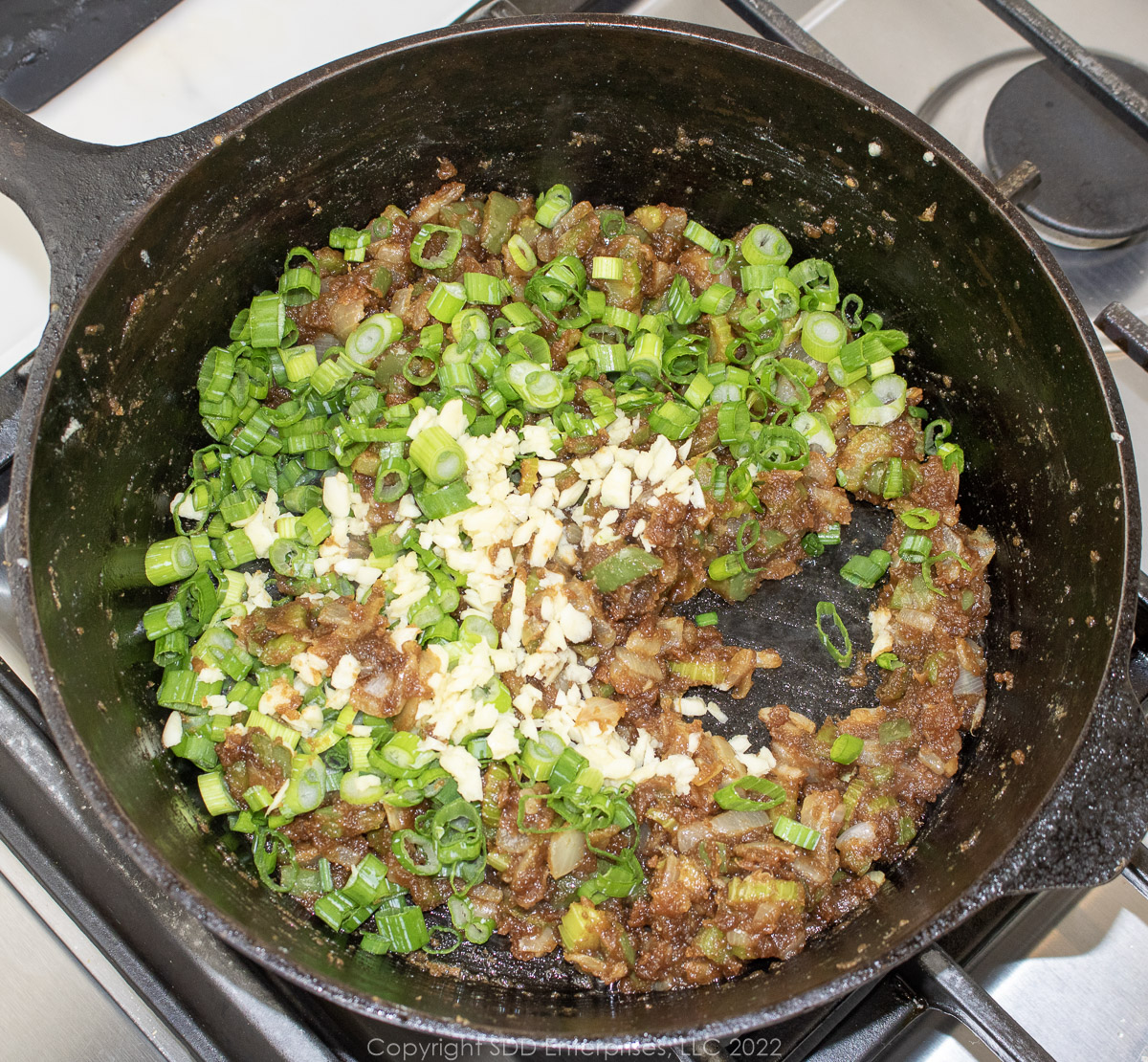
Next, add about ⅔ of the Herb and Spice blend and both bay leaves. (Reserve the remaining Herb and Spice Blend for the crawfish and to adjust seasonings later.) Stir thoroughly and continue to sauté for another 2 to 3 minutes.
Lagniappe Tip: Add ⅔ of the Herb and Spice Blend; add about half of the green onions?? Don't agonize over perfectly measuring everything. The idea is to add Herbs and Spices and green onions in different layers throughout the cooking process.
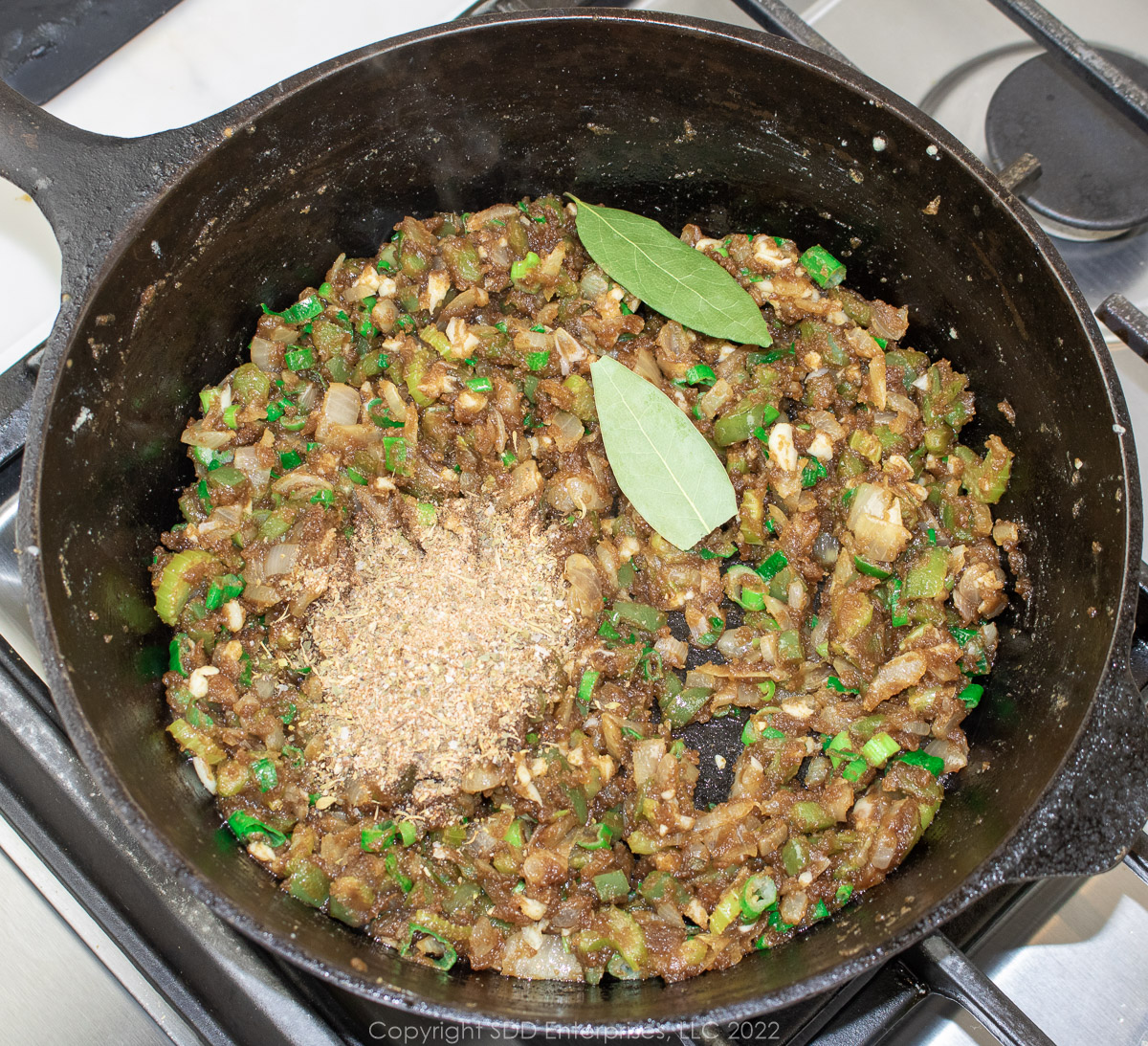
Get the stock boiling and add in the veggie/roux
What happens in this step? Now we take the layers of flavor we have created with the roux and the Trinity and add them to rich stock. This is where the intensely flavored gravy develops.
When the Trinity and roux mixture is almost ready, bring the 3 cups of stock in the stockpot to a rolling boil (make sure to reserve the other cup of stock).
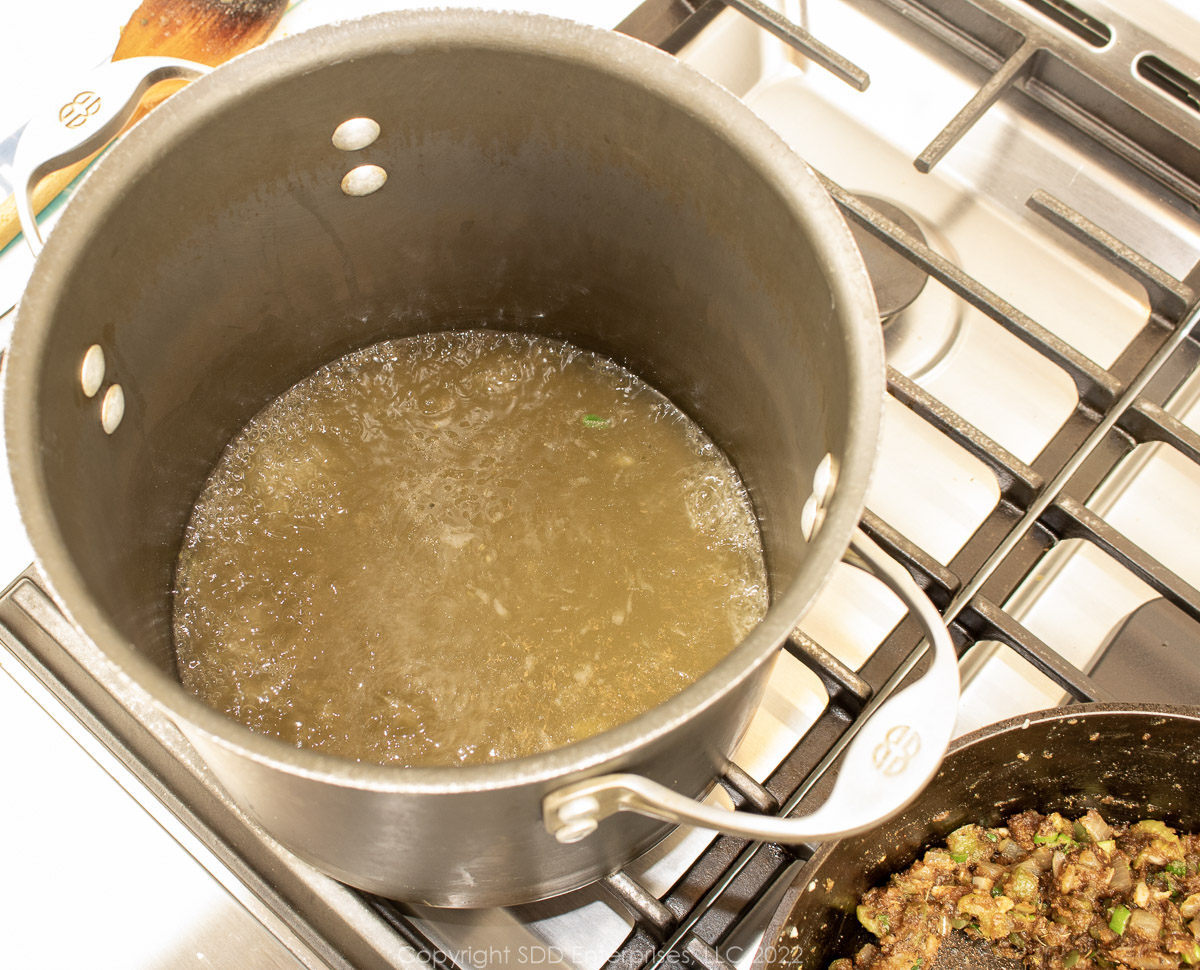
Lagniappe Tip: You can set the stock up while you're cooking the roux/veggie mixture. Lower the heat to the lowest setting under the stockpot so the stock can return to a boil quickly. Cover the stockpot until you are ready for it.
When the veggie/roux mixture is ready, return the stockpot to a high boil. Using a slotted spoon, stir the veggie/roux into the boiling stock one spoonful at a time. Make sure each spoonful is fully dissolved and the stockpot returns to a high boil before adding the next spoonful. Continue this process until all the veggie/roux mixture has been incorporated into the stock.
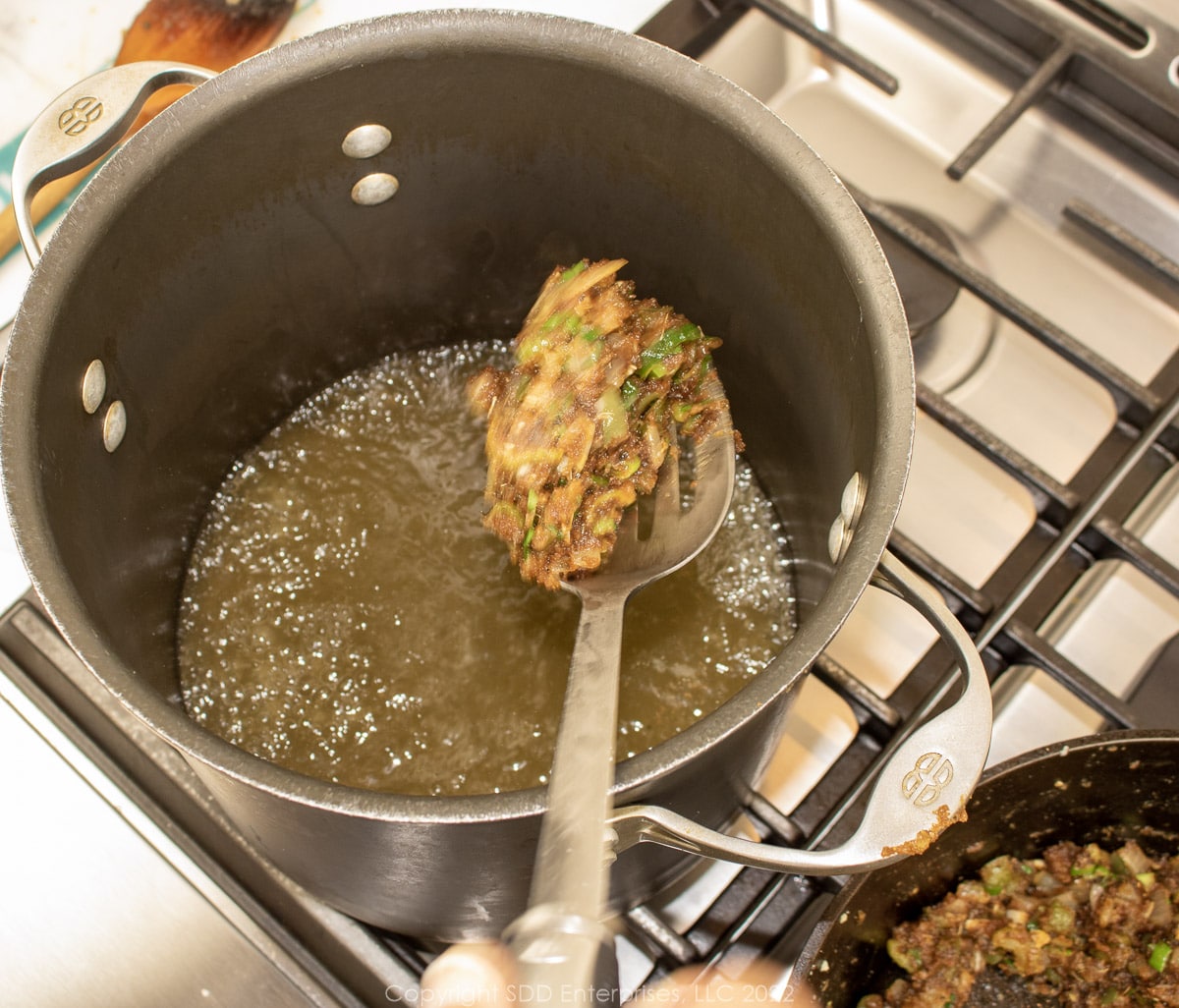
Now set the Dutch oven (used for the roux) aside. Don't rinse or wash it out yet, we want to utilize all the existing flavor in the next step. Place two tablespoons of butter in the Dutch oven and set it off the heat.
Let the gravy simmer
What happens in this step? A little time simmering together transforms the initial layers of flavor into a cohesive, intensely delicious gravy. So good, the crawfish will volunteer to jump in.
Cook the gravy in the stockpot on a high boil for about five minutes, then cover the stockpot and reduce the heat to a very low simmer for another 10 minutes. Stir frequently so it does not stick. The stock will begin to thicken through this process.
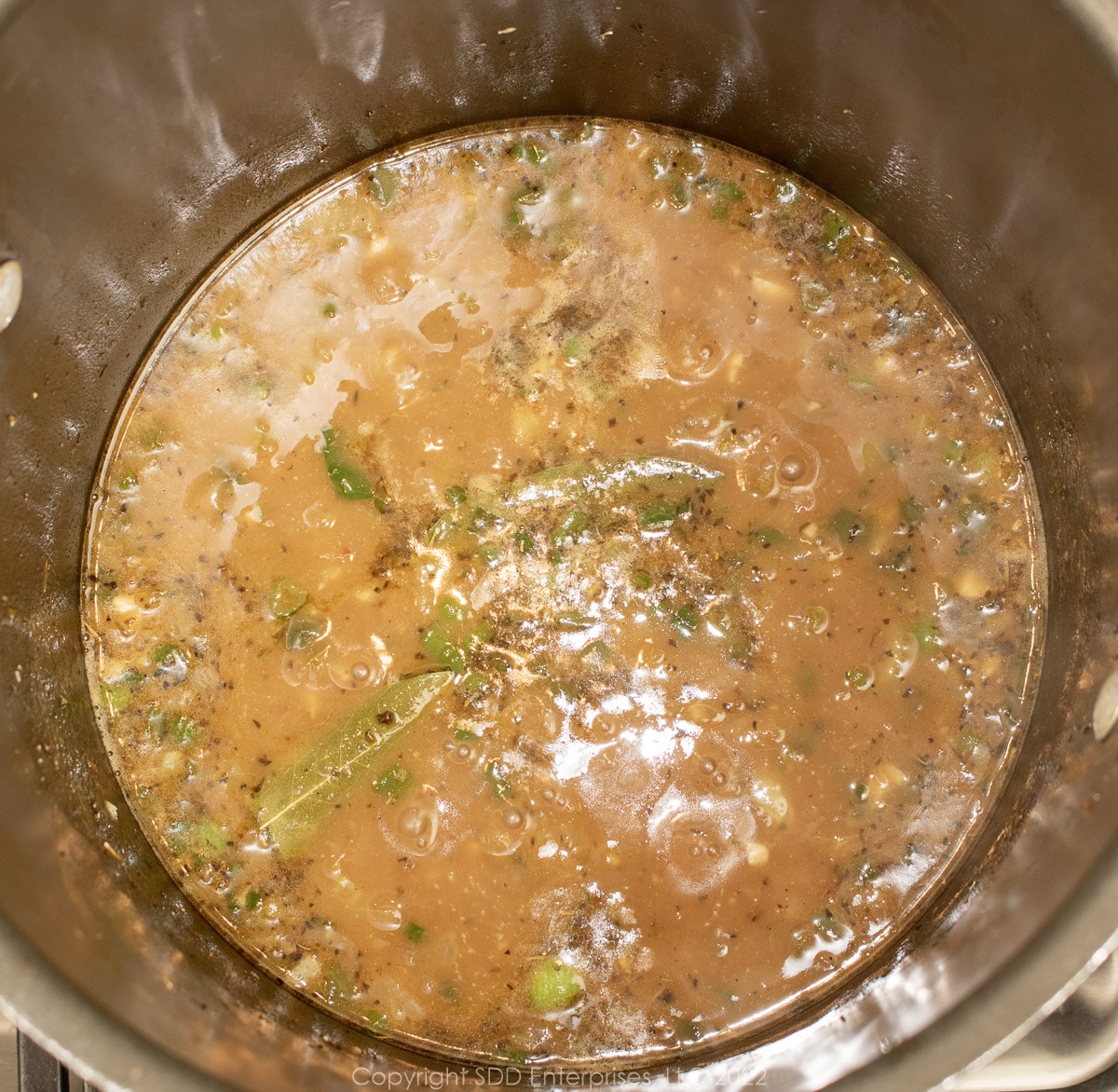
Lagniappe Tip: Don't worry too much right now if the gravy is too thick or too thin. We still have to blend it with the crawfish tails which usually generates more liquid, plus we have the reserved stock in case it's necessary to thin the gravy.
Saute the tails in butter
What happens in this step? Here we further prep the crawfish tails with butter and spices with a touch of fresh, crisp green onions.
While the gravy is simmering in the stockpot, turn the heat to medium-high under the original (roux) Dutch oven to get the butter hot. This will mix well with the flavorful morsels of fond left behind from cooking the veggies in the roux, so make sure to scrape up any bits of the fond and mix those with the melting butter. There's flavor everywhere!
When the butter is foaming (don't let it burn!) stir in about ½ to ⅔ of the reserved green onions (save some to garnish the top of the etouffée when it’s served).

Next, add the crawfish tails to the butter and mix well.
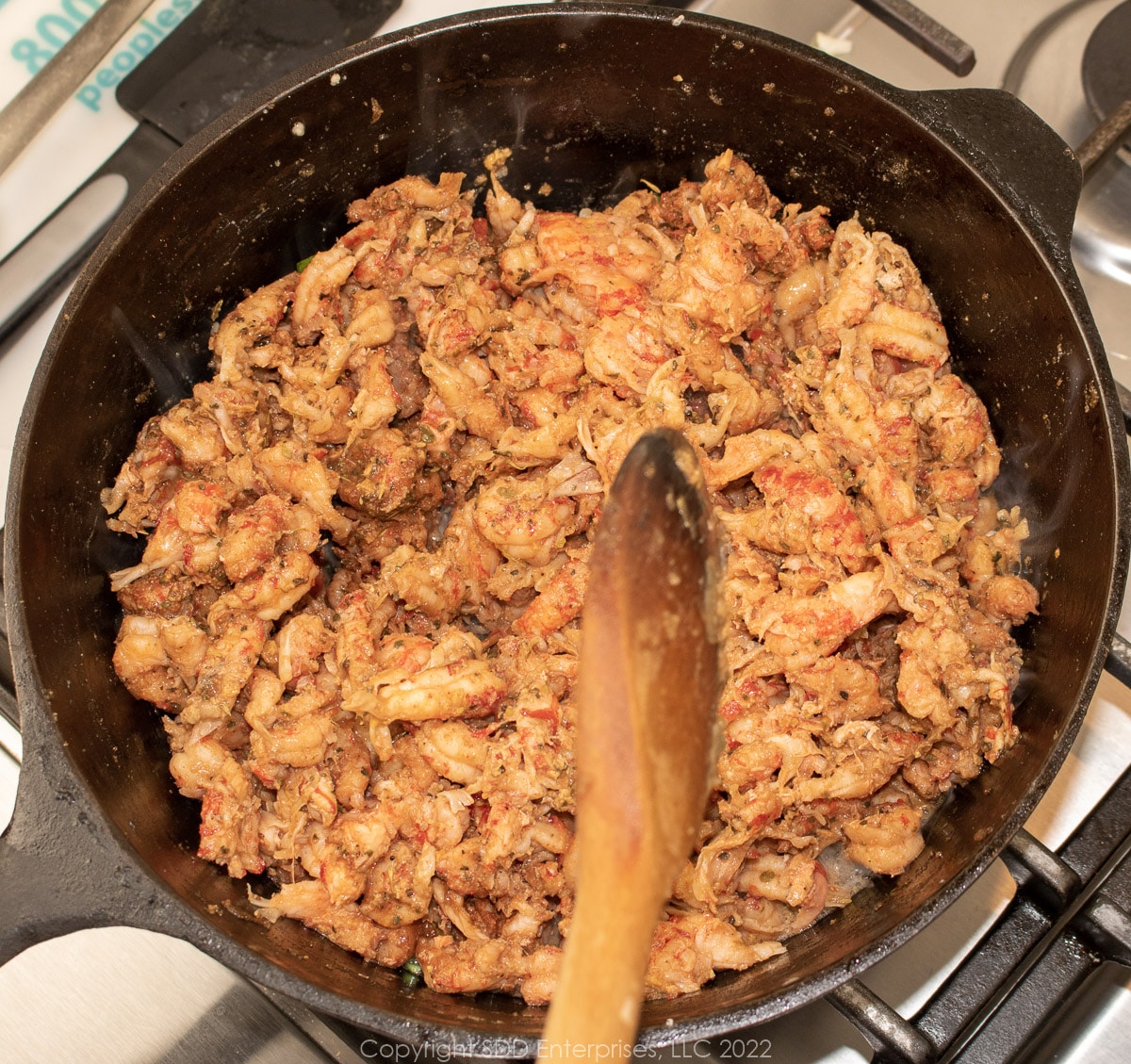
Add some of the reserved Herb and Spice Blend (the remaining will be used for seasoning adjustment if needed later) and mix everything together well to coat all the tails with butter and seasoning. Sauté for about 2 to 3 minutes, stirring constantly.
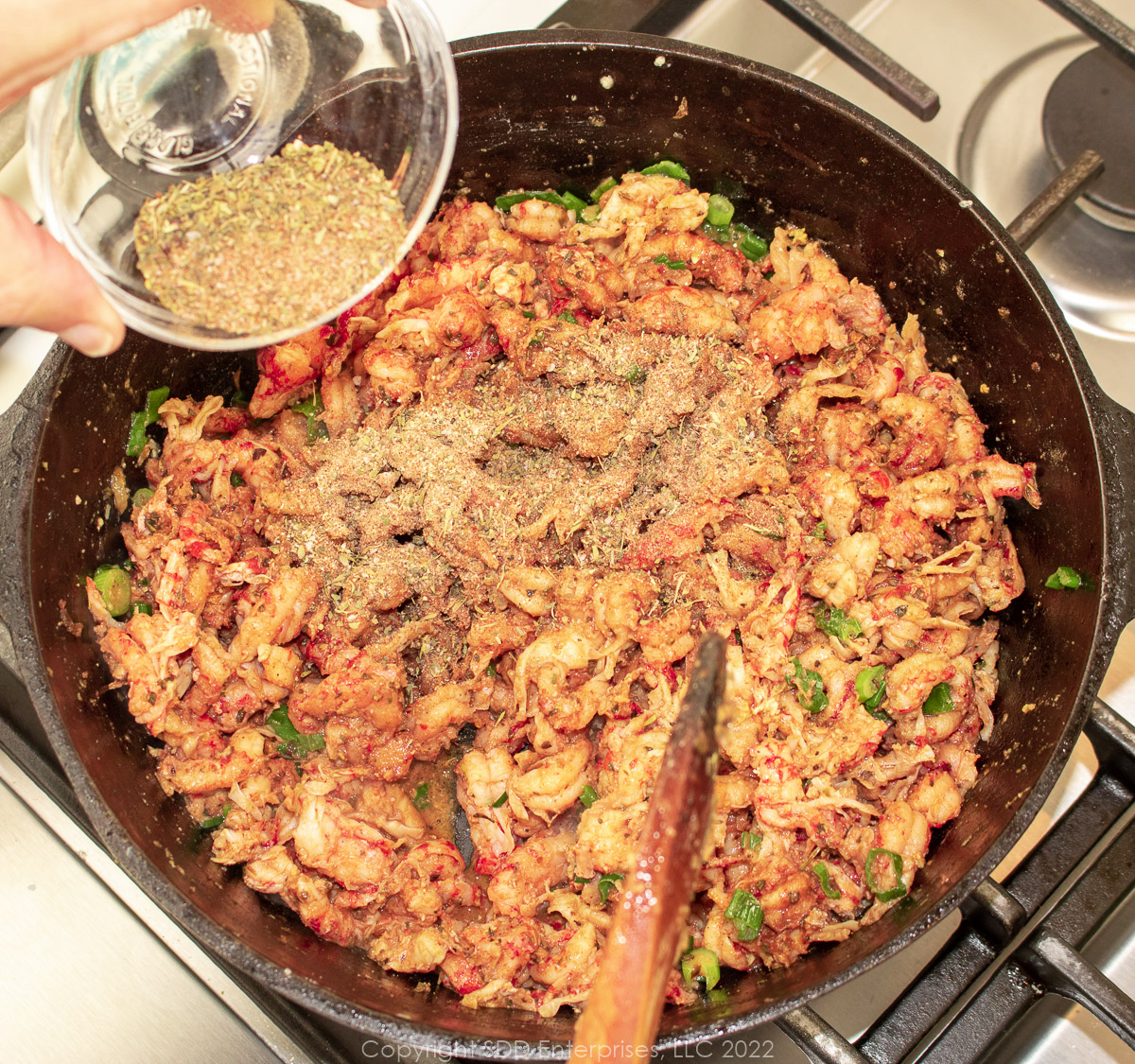
Lagniappe Tip: The tails are already cooked so you're just trying to warm them, not cook them further.
Add the gravy to the tails
What happens in this step? This is the pay-off. When we combine the gravy with the tails and let them simmer, their flavors transform into very delicious Crawfish Etouffée.
Sauteing the crawfish in butter will produce some liquid. It's OK to turn off the heat until the gravy is ready. When the gravy has simmered for about 10 minutes turn the heat to medium-high under the Dutch oven (with the crawfish). Add the gravy to the crawfish tails and mix thoroughly.
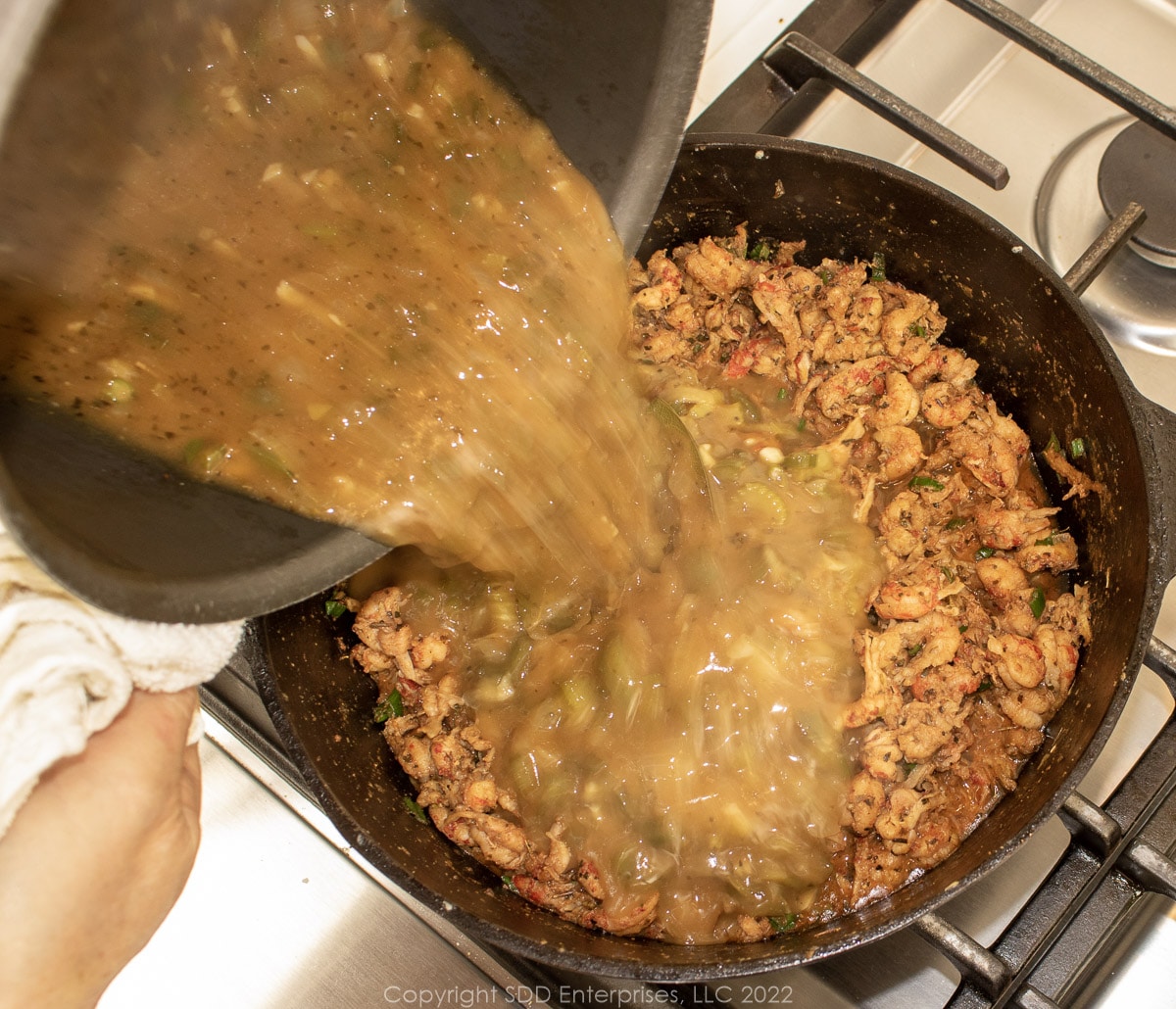
Lagniappe Tip: Sautéing the tails in butter will release some of the water from the crawfish tails and mix with the butter This will help thin the gravy.
Once you have the gravy and crawfish tails mixed, bring it to a medium simmer. Set the heat on low and let it simmer for about 20 minutes, stirring occasionally.
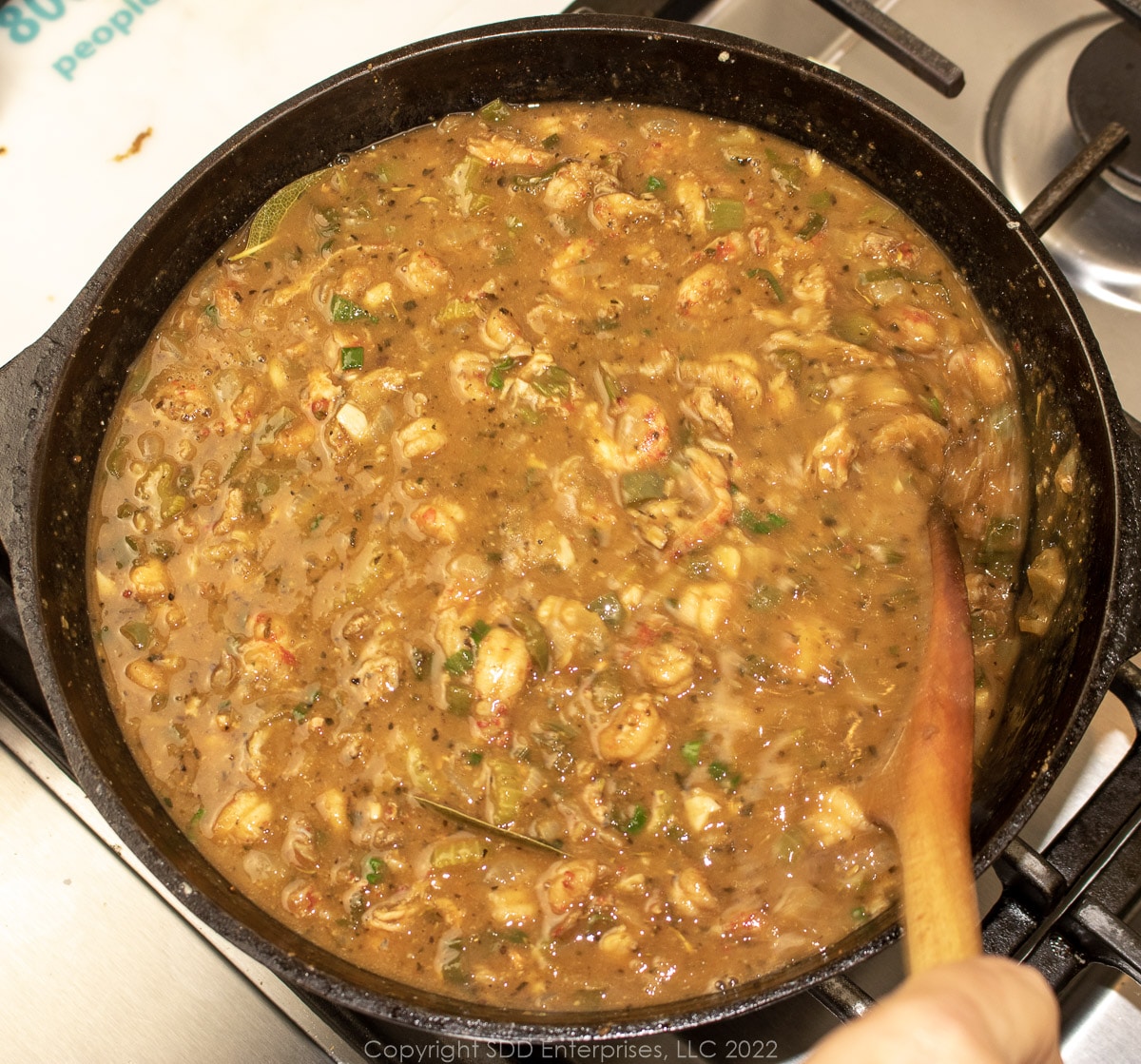
Smother until done
What happens in this step? Slowly simmering the gravy and tails further melds their flavors. Use your judgment on covering or uncovering the Dutch oven depending on your desired thickness.
After simmering for about 10 minutes, if you think it needs to be thinned out a little, add some of the reserved stock and place the cover on the Dutch oven. If it needs to thicken up a little, simmer a while longer, uncovered. You want the consistency of gravy, not a soup.
Mix well, taste for seasoning; add more salt, pepper, or Herb and Spice Blend, if needed.
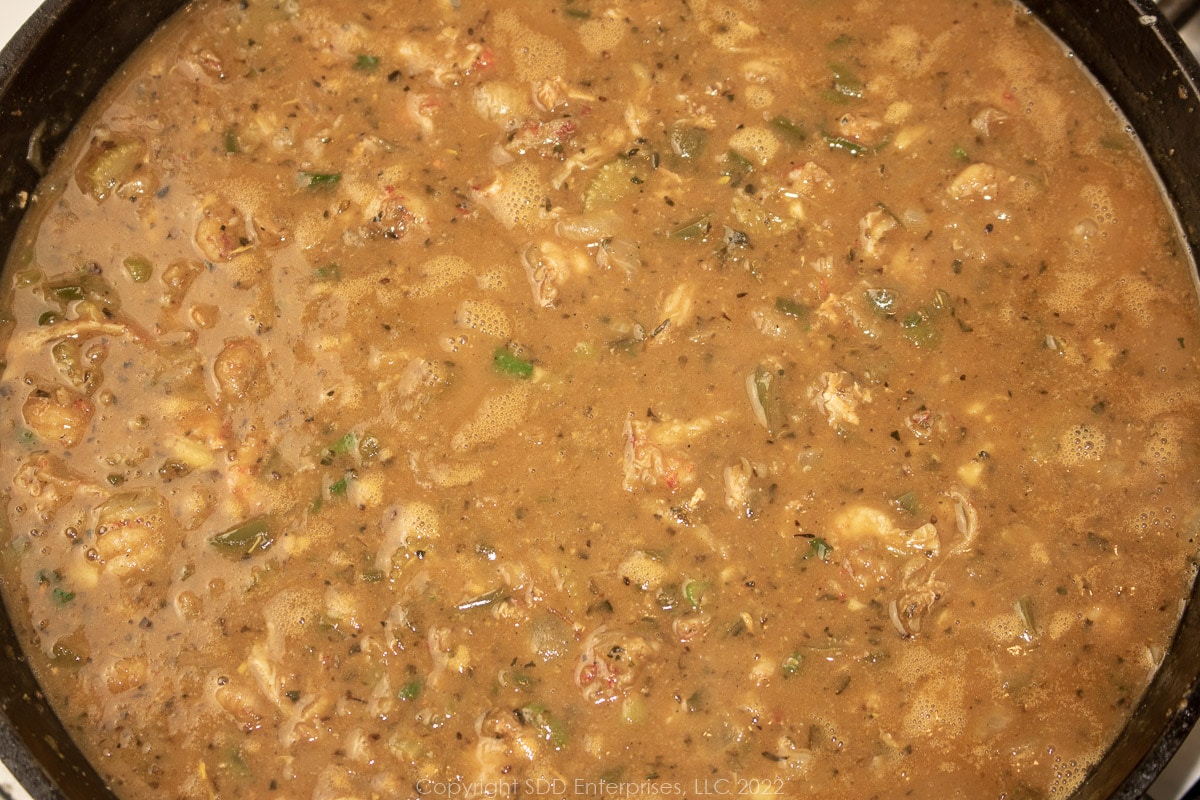
When the etouffee is just about ready, add the remaining 2 tablespoons of butter. Shake the Dutch oven back and forth while the butter melts.
Lagniappe Tip: Giving the gravy the 007 treatment (shaken, not stirred) usually results in a smoother, more cohesive gravy. As butter heats, the butterfat tends to separate from the milk solids. Shaking the pan helps keep the butter together while stirring does not provide the same effect.
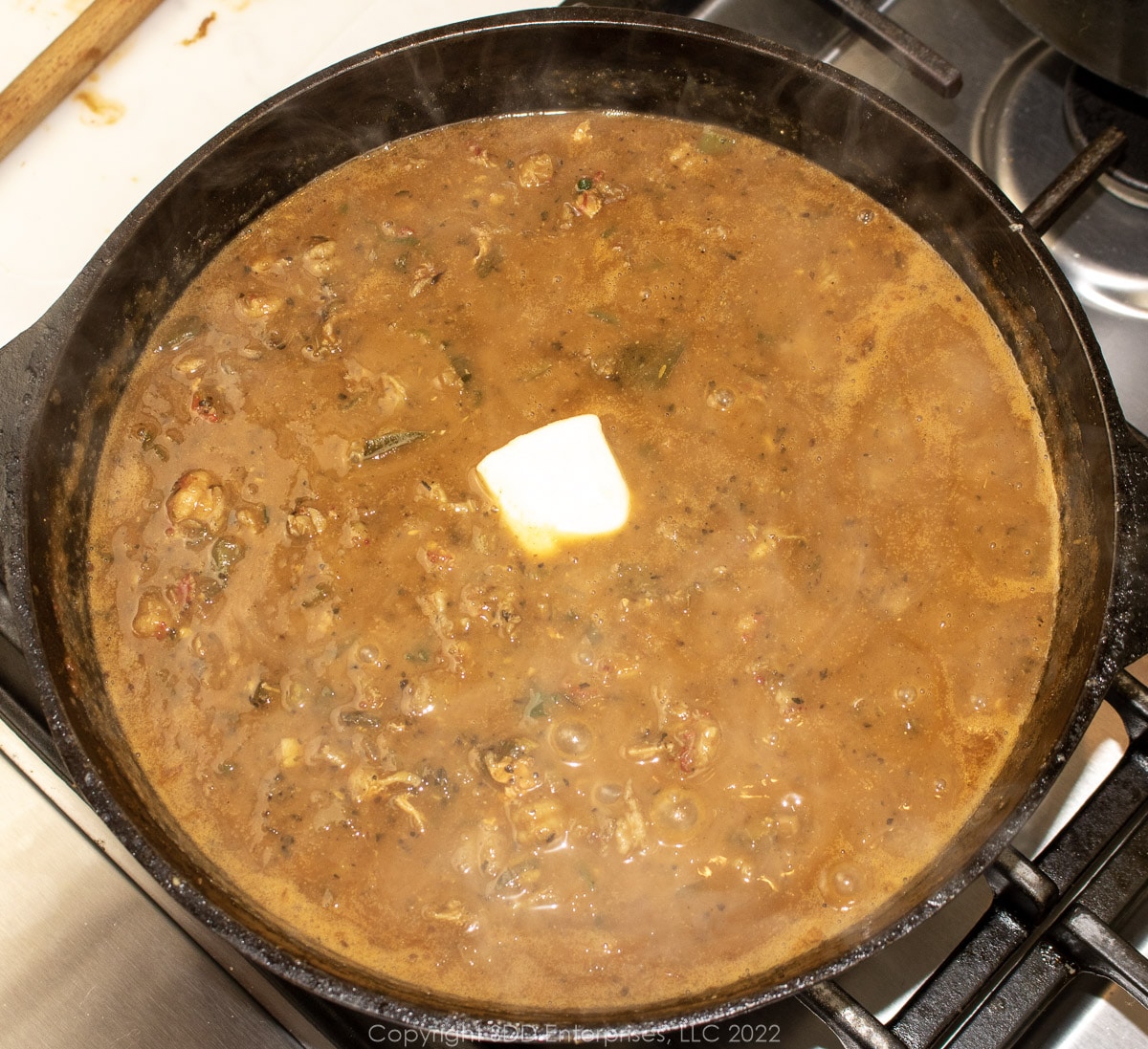
That's it, all there is to it. Remove the bay leaves and it's ready to serve over rice with a sprinkle of chopped green onions on top.
Serving Suggestion
Crawfish Etouffée is typically served as an entree over cooked long-grain white rice. If you want to use a different type of rice, or even grits or polenta, go for it. This is also fantastic served as a sauce over fried or broiled catfish, shrimp, stuffed peppers, or just about anything else you can think of.
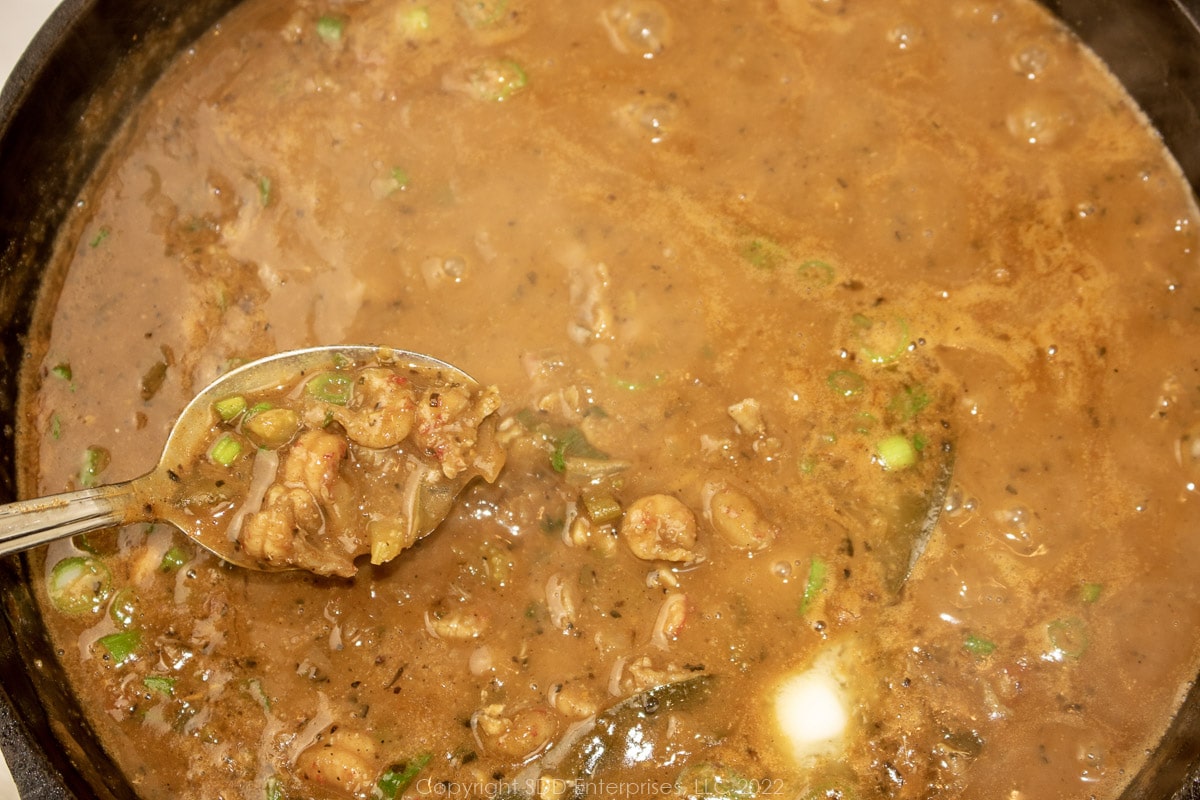
Sign up for my email notifications of new recipes and posts right HERE.
Hints and Tips (FAQs)
Etouffée is not the same thing as gumbo. Gumbo is like a soup and often contains more than one protein. Like an etouffée, gumbo usually starts with a dark roux and has many of the same vegetables and spices as Etouffee, but uses much more stock to make it like a soup. You will add some rice to the gumbo bowl, but you'll ladle etouffée on top of the rice.
Crawfish tails are definitely the star of this show. It's a perfect use for leftover tails from a crawfish boil, which provides the extra dimension of the seasoning from the boil. Peel all the remaining tails and freeze them for up to 2 months in an airtight vacuum bag. (For freezing longer than 2 months, read below). You can also use those shells to make homemade crawfish stock.
Frozen crawfish tails are usually available in most supermarkets or seafood markets, generally in 1 pound packages. It’s common to find imported crawfish tails (usually from China) but I highly recommend only Louisiana crawfish (see below). Frozen and leftover crawfish tails will already be cooked (usually parboiled), so we won't cook them very long in this recipe.
The source and quality of your seafood are very important. Crawfish tails are no exception. Freshness and quality make all the difference in flavor. Imported crawfish generally aren’t of the same quality or consistency as Louisiana tails. The real difference is in the sweetness, which lies in the "fat", the yellow-orange stuff squeezed from the head, and sticking to the tail meat. Actually, it’s not really fat at all but part of the crawfish's digestive system. (TMI?) If you can't find Louisiana tails, use the imported but make sure to rinse them as described below.
I’ve found Chinese crawfish tails often taste bitter, which is likely due to the fact that crawfish fat tends to become rancid if frozen too long. How long is too long? It can be as little as 2 months up to as long as 6 months. It takes longer for the imported crawfish to reach the market so there is more of a chance they will not be of optimal quality.
If using imported tails, or they have been frozen long (more than about 5 months) rinse them well in cold water prior to use. Let the tails drain, pat them dry with paper towels, and sprinkle on some Creole Seasoning. If you are freezing your own crawfish tail meat from a boil and know you won’t use them for more than a few months, rinse them well in cold water before you freeze them. Using a vacuum sealer and freezing at 0-degrees Fahrenheit will lengthen the time they can be frozen without loss of quality, even up to a year.
You can order online from these folks and be confident you are getting good quality products (full disclosure-I have no affiliation with the first two companies):
Cajun Grocer.Com: order online at http://www.cajungrocer.com
Tony’s Seafood Market: Shop online at http://tonyseafood.com and call 800-356-2905
Amazon (with which I am affiliated) usually has some good Louisiana Crawfish Tails.
Hard to believe you'll have any but Crawfish Etouffée can be kept in the refrigerator for 3 to 4 days, or frozen for 2 to 6 months. (See the comments above about frozen crawfish). If freezing, allow the etouffée to cool completely, then store it in a shallow airtight container, such as a vacuum-sealed bag, and place in a 0-degree Fahrenheit freezer. To reheat, let the etouffée defrost in the fridge overnight, then warm slowly in a saucepan over medium heat. It's a good option to freeze the etouffée in one or two serving portions, then you have a quick meal whenever you want it!
Crawfish are low in calories, fat, and cholesterol and are high in protein and a bunch of vitamins. They also contain a high amount of fun. That's right-they are good for you! Check out this article for a deeper look at the nutritional value of crawfish.
Here are some common ingredient substitutes for this recipe:
Too much butter for you? Substitute vegetable oil to make the roux. (I have to say, though, butter is a key ingredient for a creamy, rich gravy base).
Other proteins can be substituted for the crawfish and are quite common variations of etouffée:
Shrimp: Peel, devein and rinse the shrimp, then sprinkle with creole seasoning and set aside. Add the raw shrimp as you do the crawfish, just saute them in the butter for about 2 or 3 minutes, before you add the gravy. Even though the shrimp are not pre-cooked, they will cook very quickly in the gravy.
Chicken or rabbit: Dredge either in flour and creole seasoning and brown on all sides in the Dutch oven before you make the roux. Set the chicken or rabbit aside, then add back to the Dutch oven the same as you do the crawfish, but let them simmer in the butter for about 5 minutes before adding the gravy, then simmer the gravy for about 20 minutes.
If you don't have crawfish stock, you can substitute chicken stock, either commercial or homemade or commercial seafood stock.
Use long-grain white rice with your etouffée! If you prefer, basmati or brown rice can be substituted. I generally use par-boiled rice, like Uncle Ben's Converted, but non-parboiled long-grain rice is perfectly fine.
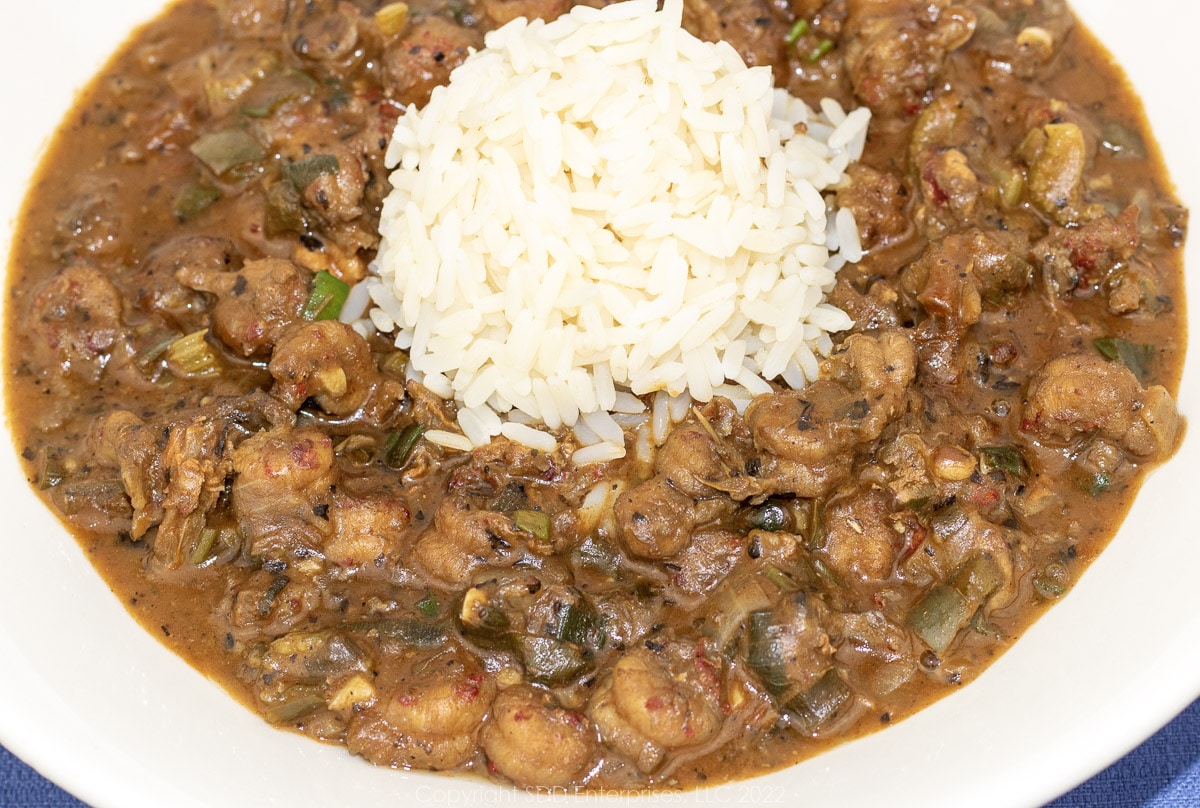
Here are some very popular CRAWFISH recipes from Sweet Daddy D:
Still looking for more Crawfish recipes? Here they are!
These sides go well with Crawfish Etouffée!
If you make this recipe:
- Tell us about it in the Comments section below
- LEAVE A RATING ON THE RECIPE-worthy of 5-Stars?
- Questions or Comments? that’s the place!
- SIGN UP FOR OUR EMAIL UPDATES so you don't miss anything!
- Post a picture and share it with your friends on our Social Media:
Yeah You Right!
Recipe

Cajun Crawfish Etouffée
Here's What You Need
- 2 pounds Louisiana crawfish tails See Recipe Notes
- 12 tablespoons Butter divided
- ½ cup all purpose flour
- 1 cup Yellow Onions diced
- ½ cup Bell Peppers diced
- ½ cup Celery chopped
- 5 - 6 cloves garlic chopped
- 2 bunches green onions chopped-in all
- 4 cups crawfish stock In all-see Recipe Notes for substitutions
Herb and Spice Blend
- 1 teaspoon Oregano
- 1 teaspoon Basil
- ½ teaspoon Thyme
- ½ teaspoon White Pepper
- 1 teaspoon fresh ground black pepper
- 2 teaspoon Creole seasoning plus some for the crawfish tails
- 1 teaspoon kosher salt
- 1 teaspoon cayenne pepper optional
- 2 bay leaves
Here's What You Do
- Place the crawfish tails in a bowl and sprinkle with some creole seasoning and set aside. Chop the yellow onions, peppers, celery and set aside in a bowl for later. Chop the green onions and set aside. Chop the garlic and set aside. Mix the Herb and Spice Blend in a small bowl. Set the butter aside to soften and the flour for the roux.
- Place about 3 cups of the seafood stock in a stockpot to warm (reserve the remainder if needed to thin the etouffée at the end).
- Place a cast-iron pan over medium-high heat. Add 8 tablespoons of butter until bubbly, then add the flour and whisk continuously to make a medium roux, the color of peanut butter, about 5 to 8 minutes. (See Recipe Notes)
- Add the onions, celery, and bell peppers (the Trinity) to the roux. Remove the Dutch oven from the heat and stir the vegetables until all coated with the roux.
- Once the Dutch oven has cooled somewhat, return to a medium heat and continue to stir occationally for atotal of 15 minutes.
- Add the garlic and about half the green onions; continue to sauté until aromatic-about 1 to 2 minutes; add about ½ of the Herb and Spice mix and both bay leaves and mix well to combine; continue to sauté about 5 more minutes.
- While the veggie/roux mixture is finishing up, turn the heat to high under the stock pot and bring the stock to a rolling boil.
- When the veggie/roux mixture is ready, mix it into the boiling stock. Usung a slotted spoon, mix in one spoonful at a time, stirring until the whole spoonful is fully dissolved. Continue this until all the veggie/roux mixture is incorporated into the stock, making sure to return the stock to a full rolling boil in between spoons. Set the cast iron pot aside, do not clean it.
- Allow the gravy to medium boil for about 5 minutes, then reduce the heat to a simmer. Cover the stockpot and simmer for 10 minutes, stirring occasionally.
- Turn the heat to medium high under the cast iron Dutch oven used for the roux and add 2 tablespoons of butter. As the butter melts scrape up any fond that's stuck to the bottom of the pan.
- When the butter is foaming, add about ½ to ⅔ of the reserved green onions (saving some to sprinkle on top of the etouffée when serving) and sauté a minute or two, then add the crawfish tails and about half of the remaining Herb and Spice Blend. Mix well until all the crawfish are coated with butter.
- Sauté about 2 to 3 minutes stirring constantly; you’ll see some liquid developing from the butter and rendering the crawfish. (See Recipe Notes).
- Add the gravy mixture to the crawfish tails and mix well. The liquid from sautéing the tails in the butter will thin out the gravy.
- Mix well, taste for spice, and add more if needed. When this comes to a heavy simmer lower the heat to a slight simmer for about 20 minutes.
- If the gravy is getting too thick, place the cover on the pan while it simmers. Add some of the reserved stock if you need to thin the gravy.
- When you have the consistency you want, add the remaining 2 tablespoons of butter and shake the pan back and forth, don’t stir, until the butter is melted into the etouffée-then give it one final gentle stir.
- Remove the bay leaves and serve over white rice.
Recipe Notes
- Butter: Substitute vegetable oil to make the roux. (Bacon grease also works!)
- Other proteins can be substituted for the crawfish and are quite common variations of etouffée: Shrimp, chicken, rabbit. Check out my Crawfish Etouffée article for more information about these versions.
- If you don't have crawfish stock, you can substitute chicken stock, either commercial or homemade or commercial seafood stock.
- Use long-grain white rice with your etouffée! If you prefer, basmati or brown rice can be substituted. I generally use par-boiled rice, like Uncle Ben's Converted, but non-parboiled long-grain rice is perfectly fine.

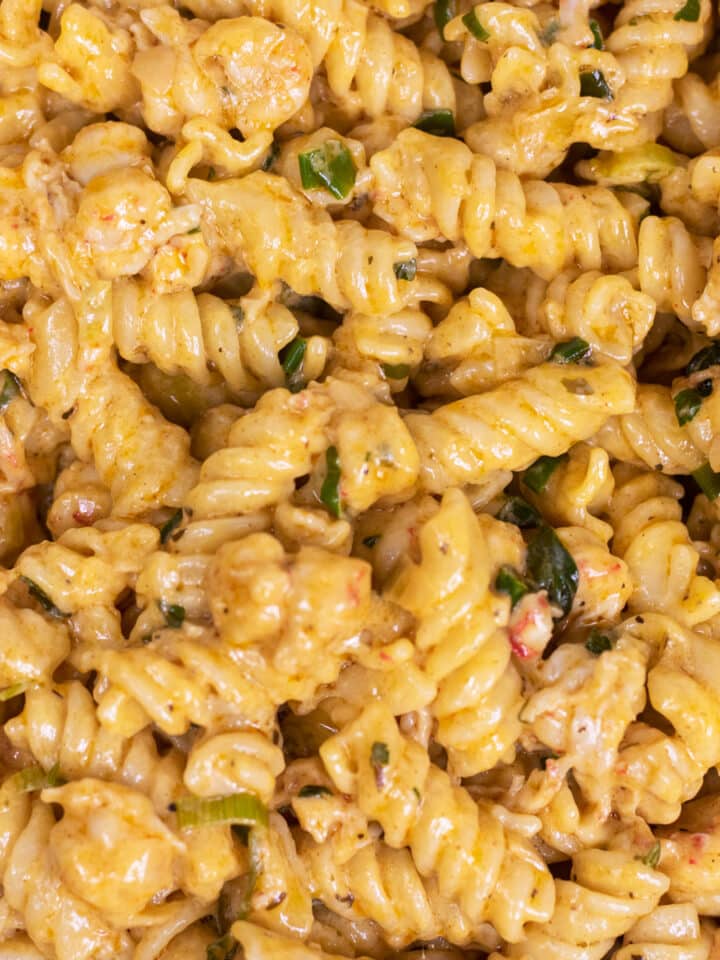



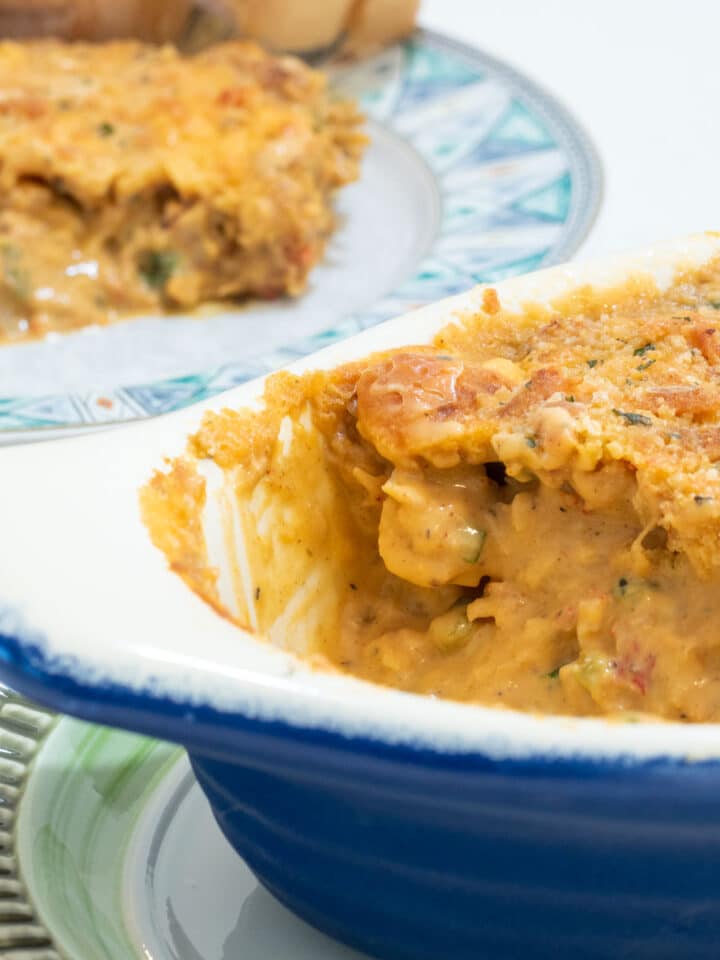
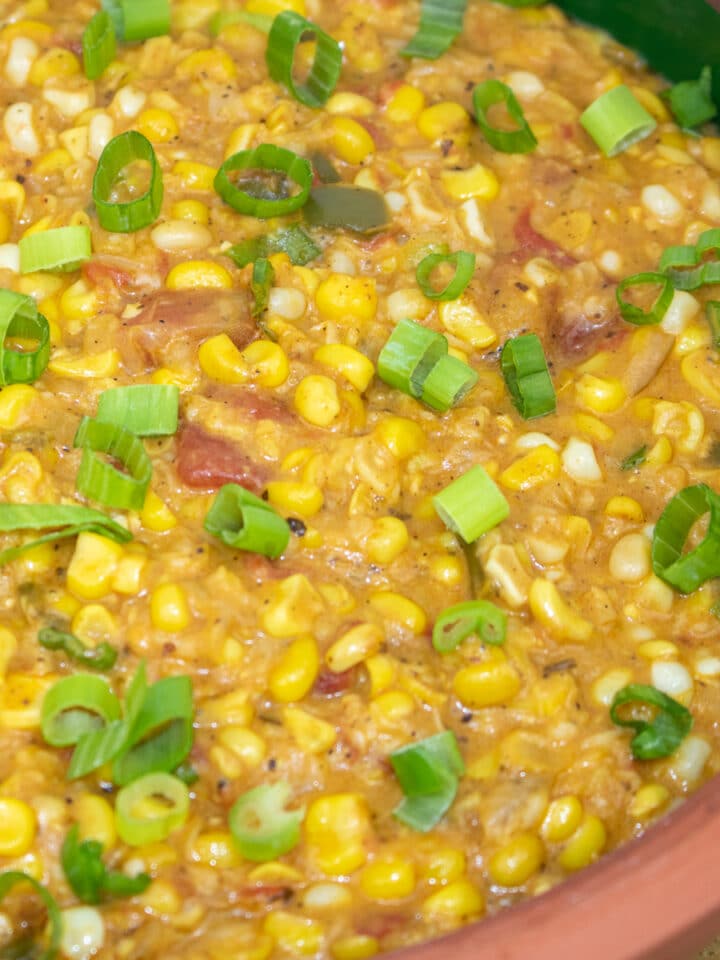
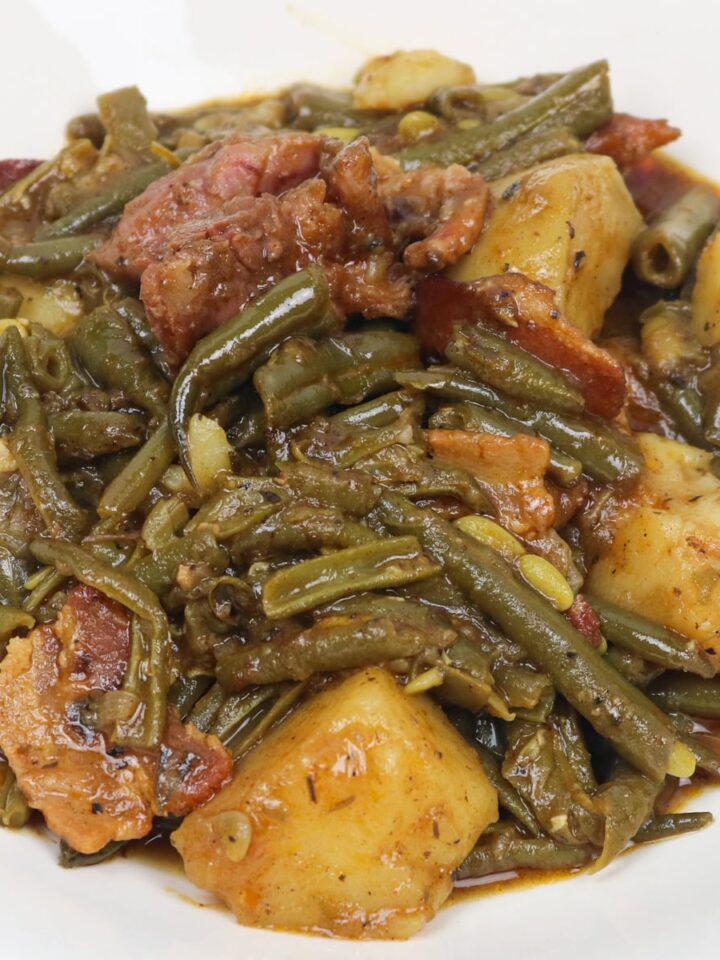
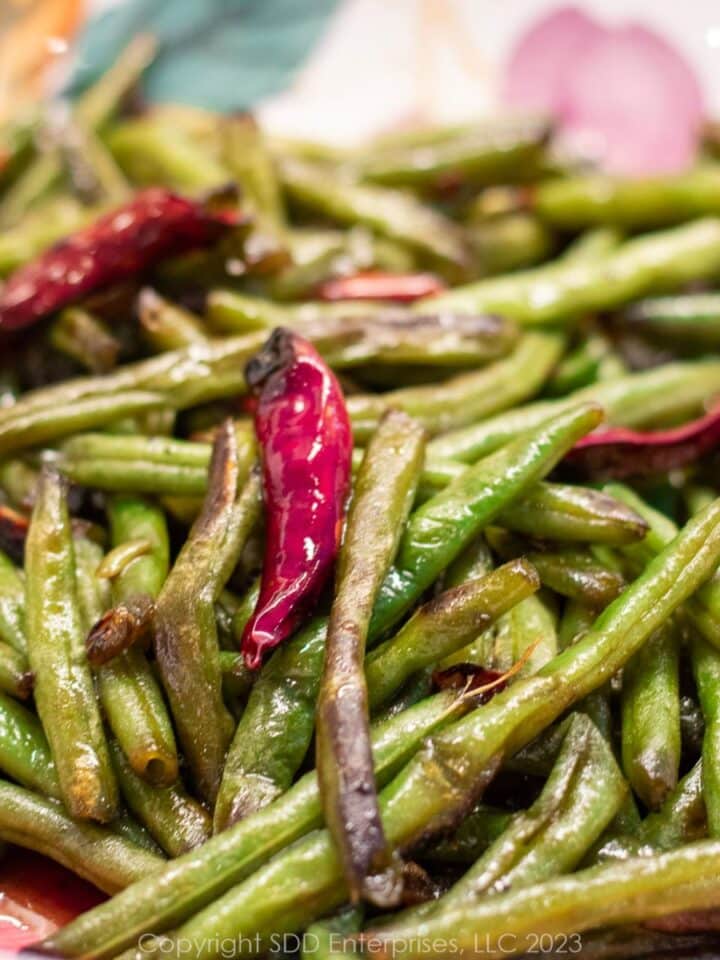
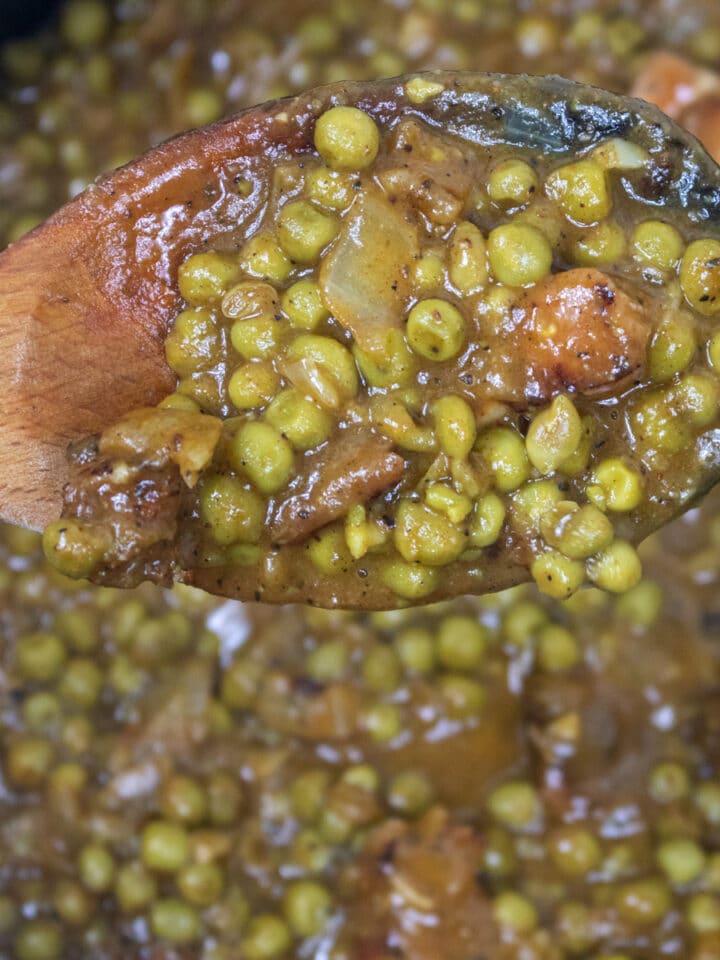
John
Just made this and it was unbelievable. Finally found my crawfish etoufee recipe! Absolutely awesome!
I did end up adding remainder of stock.
Sweet Daddy D
Yeah You Right, John. Thanks for giving the recipe a try. I'm really glad you liked it!
R. Hirsch
Intensely flavorful version of classic Louisiana seasonal dish. As the recipe says, Louisiana crawfish tails are a must. We agree with Daddy D that imported (Asian) crawfish tails lack the size, flavor, and freshness of Louisiana wild or pond raised crawfish, and can have an unpleasant flavor. Don't even be tempted just because the imported are just a few dollars cheaper per pound. Not worth it! This delicate crawfish tail meat could have been frozen, thawed, re-frozen countless times during months long, round the world journey on container ships. Daddy D's recipe is pure Cajun goodness. We have cooked his exact recipe as well as some slight variations where we cut down on the amount of flower to produce a thinner, lighter version of the "gravy," and have minimized or eliminated the oregano as well. This is personal taste and preference however, such as with gumbo - there are customs and preferences that can differ simply by community, just miles apart. No right or wrong, and Daddy D's recipe is excellent, both with our slight accommodations to taste or as is. I definitely favor the use of crawfish stock or commercial seafood stock which we used, as compared to many other recipes that don't use this. Don't skimp on the butter, and don't even think about deviating from Daddy D's recipe and using margarine! Buttery, spicy, crawfish goodness.
Sweet Daddy D
Thanks for the great review, @rhirsch! Louisiana Tails, good stock and lots of butter...that's the ticket! Glad you enjoyed it!
Jim R
This recipe took a bit of preparation and time but it is well worth the effort. WOW! This was better than many etoufee I had on visits to Louisiana. Amazing depth of flavor and just pure delicious. I did not have enough crawfish so I added some sliced linguisa sausage and it was great. Even reheated it with some added shrimp and it worked well. A great recipe and very well documented so it was easy to follow. Highly recommend if you want to bring true Cajun cooking to your home!
Sweet Daddy D
Yeah you right, Jim R! Thanks for giving it a try and so glad you liked it. Come back and see us!